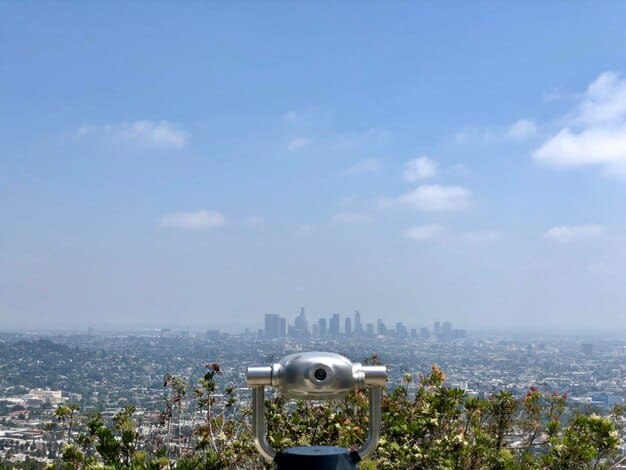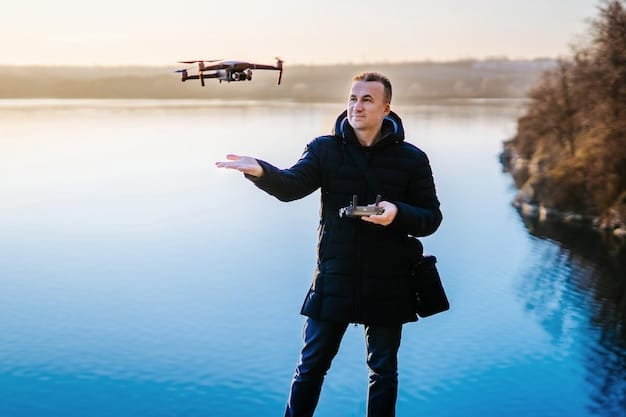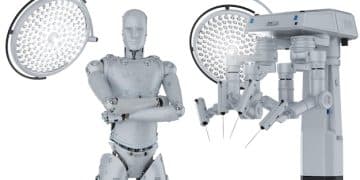US Drone Regulations: A Comprehensive Guide to Commercial Use

The US government regulates the use of drones for commercial purposes through the Federal Aviation Administration (FAA), which sets rules for registration, operation, and certification to ensure safety and security.
The world of commercial drones is rapidly evolving, and understanding The FAA is the primary authority responsible for regulating all aspects of aviation in the United States, including the burgeoning drone industry. Its mission is to ensure the safety and efficiency of the national airspace system. This includes drones, officially known as unmanned aircraft systems (UAS). The FAA’s regulations for commercial drones are designed to mitigate risks associated with their operation, such as collisions with manned aircraft or injuries to people on the ground. These regulations cover a wide range of aspects, including drone registration, pilot certification, and operational restrictions. Several key regulations govern the commercial use of drones in the US. Understanding these rules is essential for anyone planning to operate drones for business purposes. Part 107 is particularly important, as it provides a comprehensive framework for commercial drone operations. It covers aspects such as visual line of sight requirements, altitude restrictions, and operating hours. In conclusion, the FAA plays a pivotal role in regulating commercial drone operations in the US. By understanding and complying with these regulations, businesses can safely and legally utilize drones for a variety of applications. One of the first steps in operating a drone for commercial purposes is registering it with the FAA. This process helps the agency track drones and ensure accountability. Additionally, the FAA has implemented Remote ID requirements to enhance safety and security. Registering your drone involves providing information about the aircraft and its owner. The FAA uses this information to maintain a database of registered drones, which can be used in the event of an accident or security incident. The FAA provides an online portal for drone registration. The process is relatively straightforward and requires the following steps: Once registered, the drone owner receives a registration certificate, which must be kept in their possession during drone operations. The registration is valid for three years. Remote ID is a relatively new requirement that mandates drones to broadcast identification and location information. This rule aims to improve airspace awareness and accountability. There are three ways to comply with Remote ID requirements: Remote ID is crucial for enhancing the safety and security of drone operations, as it allows the FAA and law enforcement to identify and track drones in real-time. Registering your drone and complying with Remote ID requirements are essential steps for operating drones legally and responsibly in the US. These measures help ensure the safety and security of the national airspace system. Operating a drone for commercial purposes in the US requires a pilot certification issued by the FAA. This certification, known as the Part 107 certificate, ensures that drone pilots have the knowledge and skills necessary to operate drones safely. Obtaining a Part 107 certificate involves passing an aeronautical knowledge test and meeting certain eligibility requirements. The test covers topics such as airspace regulations, weather, and drone operations. To be eligible for a Part 107 certificate, individuals must meet the following requirements: The aeronautical knowledge test covers a wide range of topics, including airspace classifications, operating requirements, aviation weather sources, and emergency procedures. There are numerous training resources available to help individuals prepare for the Part 107 knowledge test: These resources can help aspiring drone pilots gain the knowledge and skills necessary to pass the aeronautical knowledge test and operate drones safely and legally. Pilot certification is a critical aspect of commercial drone operations. By obtaining a Part 107 certificate and staying up-to-date with the latest regulations, drone pilots can ensure the safety and compliance of their operations. The FAA imposes various operational restrictions on commercial drone operations to ensure safety and prevent interference with other aircraft. These restrictions cover aspects such as altitude, speed, and operating areas. However, the FAA also provides a process for operators to apply for waivers to certain restrictions. Understanding these restrictions and the waiver process is essential for commercial drone operators to plan and execute their operations legally and efficiently. Some of the most common operational restrictions for drones include: These restrictions are designed to minimize the risk of collisions with manned aircraft and ensure the safety of people and property on the ground. The FAA allows operators to apply for waivers to certain Part 107 rules if they can demonstrate that their proposed operation can be conducted safely. Some of the most common waivers include: To obtain a waiver, operators must submit a detailed application to the FAA, outlining the proposed operation and demonstrating how they will mitigate any associated risks. The FAA reviews each application on a case-by-case basis. Compliance with operational restrictions is crucial for ensuring the safety and legality of commercial drone operations. However, the waiver process provides flexibility for operators who can demonstrate that their proposed operations can be conducted safely under alternative conditions. As drones become more prevalent in commercial applications, privacy and data security concerns have become increasingly important. Drones equipped with cameras and sensors can collect vast amounts of data, raising questions about how this data is used and protected. Addressing these concerns is essential for building public trust and ensuring the responsible use of drone technology. While there is no single federal law specifically addressing drone privacy, several federal and state laws offer some protection: These laws provide a framework for addressing privacy concerns related to drone operations, but they may not cover all potential scenarios. In addition to complying with legal requirements, drone operators should adopt best practices for protecting privacy and data security: By following these best practices, drone operators can demonstrate their commitment to protecting privacy and data security. Privacy and data security are critical considerations for commercial drone operations. By understanding and addressing these concerns, businesses can build trust with customers and the public, ensuring the long-term sustainability of the drone industry. The regulatory landscape for commercial drones in the US is constantly evolving as technology advances and new applications emerge. The FAA is working to adapt its regulations to keep pace with these changes while maintaining safety and security. Several key trends are shaping the future of drone regulation in the US, including the integration of drones into the national airspace system and the development of new technologies like drone delivery and autonomous flight. Some of the key trends shaping the future of drone regulation include: These trends reflect the growing importance of drones in various industries and the need for a regulatory framework that supports innovation while ensuring safety and security. Looking ahead, several changes in drone regulations are anticipated: These changes will create new opportunities for commercial drone operators while promoting safety and innovation. The future of drone regulation in the US is dynamic and promising. By staying informed about the latest developments and engaging with the FAA, businesses can position themselves to take advantage of the opportunities presented by this rapidly evolving technology. Part 107 is the FAA regulation that governs the operation of small unmanned aircraft systems (drones) for commercial purposes, covering pilot certification, operational limitations, and aircraft requirements. You can register your drone online through the FAA DroneZone website. You’ll need to provide information about the drone and pay a registration fee. The drone then needs to be marked with the registration number. Remote ID requires drones to broadcast identification and location information, enhancing airspace awareness and accountability. It helps the FAA and law enforcement track drones in real-time for safety and security. Common restrictions include altitude limits (400 feet AGL), visual line of sight requirements, daylight-only operations, and speed limits (87 knots). These restrictions ensure safety and prevent collisions with manned aircraft. You can apply for waivers to certain Part 107 rules by submitting a detailed application to the FAA, outlining your proposed operation and how you will mitigate any risks. The FAA reviews applications case-by-case. Navigating the US government’s regulations on commercial drone use requires a thorough understanding of FAA guidelines, registration processes, pilot certifications, and operational restrictions. By staying informed and compliant, businesses can harness the potential of drone technology while ensuring safety and respecting privacy.Understanding the FAA’s Role in Drone Regulation
Key FAA Regulations for Commercial Drones

Drone Registration and Identification Requirements
How to Register Your Drone with the FAA
Understanding Remote ID Requirements
Pilot Certification and Training for Commercial Drone Operations
Requirements for Obtaining a Part 107 Certificate
Training Resources for Aspiring Drone Pilots

Operational Restrictions and Waivers for Drone Use
Common Operational Restrictions for Drones
Applying for Waivers to Operational Restrictions
Privacy and Data Security Considerations
Federal and State Laws on Drone Privacy
Best Practices for Protecting Privacy and Data Security
The Future of Drone Regulation in the US
Key Trends Shaping Drone Regulation
Anticipated Changes in Drone Regulations
Key Point
Brief Description
📝 FAA Regulations
The FAA sets rules for drone registration, operation, and pilot certification.
🆔 Remote ID
Drones must broadcast identification and location for safety and accountability.
👨✈️ Pilot Certification
Commercial drone pilots need a Part 107 certificate.
🛡️ Privacy
Drone operators must consider privacy and data security.
Frequently Asked Questions
▼
▼
▼
▼
▼Conclusion





